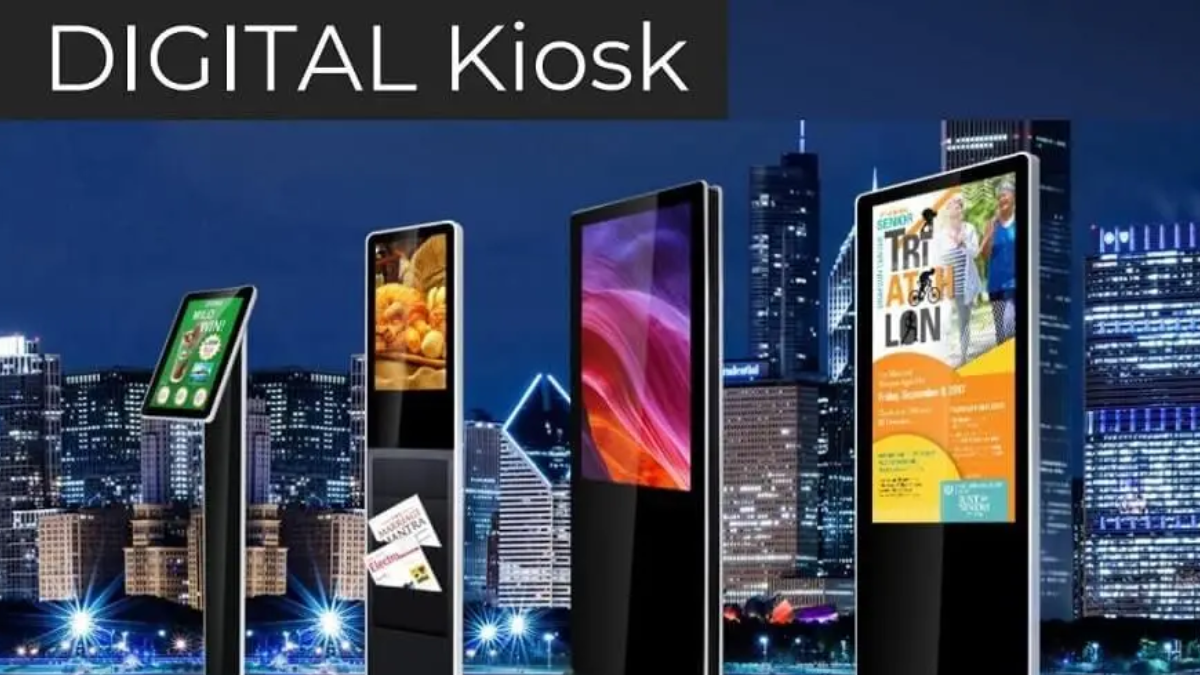In this time period of advanced technology, digital kiosks have become an important part of our daily lives. Providing restroom and skillfulness in various settings. These interactive displays, often seen in public spaces, retail stores, and educational institutions, have changed the way we access information and services.

What is a Digital Kiosk?
Imagine a smart screen that allows you to move with it, that’s a digital kiosk! These user friendly devices come in different shapes and sizes, equipped with touchscreens and user overlap designed for easy transport. You might have targeted them at shopping malls, airports, or even in your school’s hall.
The Basics of How They Work:
There functions on a simple principle: user interaction. A touch sensitive screen is the primary interface, get rid of the need for a keyboard or mouse. Users can navigate through options, select choices, and receive information with just a single tap on the screen. Behind the scenes, a computer system processes these inputs and provides the desired output.
Where Can You Find Digital Kiosks?

Digital kiosks are variable and can be found in several settings. Here are some common places where you might encounter them:
Retail Stores:
Digital kiosks in marketing settings offer a pleasing way for customers to browse products, check prices, and even place orders.
They improve the shopping experience by providing detailed information about products and promotion.
Airports and Transportation Hubs:
Travelers mostly use digital kiosks for self check in at airports. These kiosks print construction passes and provide necessary flight information.
In transportation part, they provide route maps, schedules, and other related details for commuters.
Educational Institutions:
Schools and universities use digital kiosks to display announcements, event dates, and field maps.
Students can instantly access information about courses, exams, and other academic matters.
Government Offices:
Digital kiosks feature services in government offices, helping the citizens to access information about public services, submit forms, and check the status of applications.
- Four Digits to Master the NYT Crossword
- Digital minimalism
- Best game engines as of 2024
- The Four-Digit Technique NYT
- Digital Marketing Internship – 2024
- Snail mail game on 3rd December 2003
- Best 4X games of all time

Benefits of Digital Kiosks
Accessibility:
Digital kiosks makes information accessible to everyone, including those who may have difficulty using long standing methods.
They often come with features like changeable text size and audio options to provide to a different audience.
Efficiency:
Transactions and processes become more time saving with digital kiosks. For example, self checkout kiosks in stores decrease waiting times at the cash register.
In educational settings, students can quickly find the information they need without having to wait in long lines.
Cost-Effectiveness:
With the passage of time, digital kiosks can prove to be cost efficient for businesses and organizations. They reduce the need for printed materials and can handle multiple tasks at the same time.
Engagement:
Digital kiosks interest users with interactive content, making the experience more pleasant and memorable.
Wholesale use them to display case a product features through interactive displays, attracting customer’s attention.
Challenges and Considerations
While digital kiosks offer numerous benefits, there are also some challenges to be awaken of:
Maintenance:
Daily maintenance is necessary to assure that digital kiosks is functioning smoothly. Technical fault or hardware issues may up rise and need prompt attention.
Security:
As with any technology, guaranteeing the security of user data is important. Organizations must apply measures to protect irritable information and prevent unlicensed access.
User Training:
While digital kiosks are designed to be user-friendly, some individuals may still require basic training to navigate through the interface. Clear instructions and intuitive design can apologies this challenge.
The Future of Digital Kiosks
As technology continues to advance, the ability of kiosks are also evolving. We can expect to see more intelligent features, such as facial recognition, increased reality, and even artificial intelligence integration. These advancements goal to further improve user experiences and increase the efficiency of various processes.
Conclusion
Digital kiosks have changed the way we act with information and services in public spaces, selling environments, and educational institutions. Their user friendly interfaces make them reachable to people of all ages and backgrounds. As technology continues to evolve, we can look onward to even more exciting developments in the world of digital, making our daily lives more favorable and connected.






